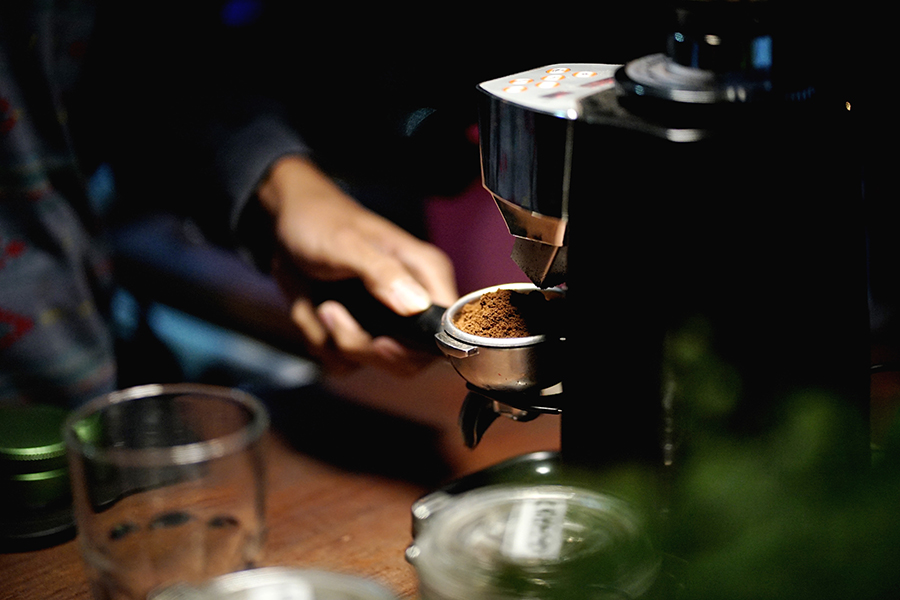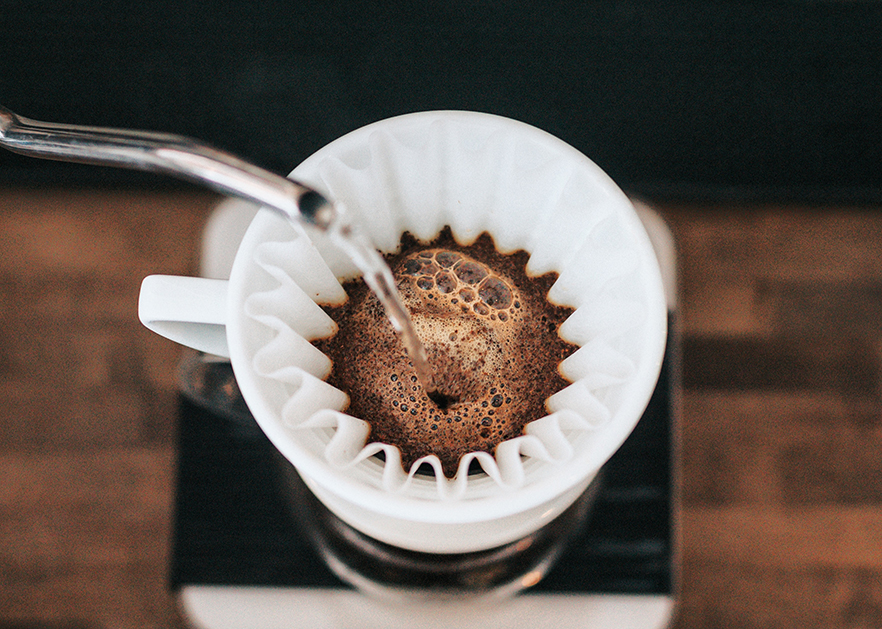Coffee, a beloved beverage many worldwide enjoy, is as diverse as it is delicious. One of the key factors that contribute to its diversity and flavor is the coffee grind size. The grind size is a reference to the size of the coffee particles after the beans have been ground.
This seemingly minor detail plays a significant role in your coffee’s taste, aroma, and overall quality and in this article we explore coffee grind sizes and their effect on brewing.

The Importance of Grind Size in Coffee Brewing
The grind size is crucial in coffee brewing because it directly affects the extraction process. When your hot water gets into contact with the coffee grounds, it begins to dissolve or extract the compounds in the coffee. These compounds are what give coffee its distinct flavor and aroma.
The size of the coffee grounds determines how quickly or slowly the water can extract these compounds. Larger, coarser grounds have less surface area exposed to the water, which means the water will extract the compounds more slowly. Conversely, smaller, finer grounds expose more surface area, leading to faster extraction.
If the grind is too coarse for the brewing method, the water will pass through the grounds too quickly, leading to under-extraction. Under-extracted coffee can taste weak, sour, or even salty because the water needs more time to extract the full range of flavors from the coffee.
On the other hand, if the grind is too fine, the water will pass through the grounds too slowly, leading to over-extraction. Over-extracted coffee can taste bitter or astringent because the water has extracted too many compounds from the coffee, including undesirable ones.
Therefore, the grind size plays a crucial role in the extraction process, and getting it right can make the difference between a superb cup of coffee and a disappointing one.
A Detailed Description of Different Grind Sizes and Their Uses
Understanding the different grind sizes and their uses is crucial for brewing delicious coffee. Here’s a detailed description of the main grind sizes:
- Extra Coarse: Similar to peppercorns. Ideal for cold brew and cowboy coffee.
- Coarse: Similar to sea salt. Perfect for French press, percolators, and cupping.
- Medium-Coarse: Similar to coarse sand. Works well with Chemex and Clever Dripper.
- Medium: Similar to regular sand. Suitable for drip coffee makers and siphon coffee.
- Medium-Fine: Finer than sand. Suitable for pour-over cones, vacuum pots, and AeroPress (with a 3-minute brew time).
- Fine: Similar to table salt. Ideal for espresso machines and AeroPress (with a 1-minute brew time).
- Extra Fine: Similar to powdered sugar. Used for Turkish coffee.
Each grind size has a specific use, and using the right grind size can significantly enhance the flavor of your coffee.
Selecting the Correct Coffee Grind Size for Different Brewing Methods
Choosing the correct grind size for your coffee brewing method is crucial for achieving optimal flavor. Here’s a simple guide:
- French Press: Use a coarse grind. The French press involves a longer extraction time, and a coarse grind will prevent over-extraction.
- Pour-Over: Use a medium to medium-fine grind. The pour-over method is the pouring of hot water over the coffee grounds and letting it drip through a filter. A medium grind will ensure balanced extraction.
- Espresso: Use a fine grind. Espresso involves forcing hot water through the coffee grounds under high pressure, and a fine grind will ensure optimal extraction.
- Turkish Coffee: Use an extra fine grind. Turkish coffee involves boiling finely ground coffee in water, and an extra fine grind will result in a rich and flavorful cup.
Remember, these are just guidelines. You may need to alter the grind size slightly depending on the specific beans you’re using and your taste preferences.
The Impact of Grind Size on Coffee Flavor
The grind size has a direct impact on the flavor of the coffee. As mentioned earlier, the grind size affects the extraction process, and the extraction process determines the flavor of the coffee.

When coffee is extracted correctly, it has a balanced flavor. You can taste the sweetness, acidity, and bitterness in harmony, and you can also taste the unique flavors of the coffee’s origin, such as fruity, chocolatey, or nutty notes.
However, when coffee is under-extracted due to too coarse a grind, it can taste sour because the acidic compounds are the first to be extracted. It can also taste weak and watery because not enough flavor compounds have been extracted.
When coffee is over-extracted due to too fine a grind, it can taste bitter because the bitter compounds are the last to be extracted. It can also taste overly strong and need more subtle flavors of the coffee’s origin.
Therefore, the grind size can make the difference between a flavorful, balanced cup of coffee and a cup of coffee that is too sour, too bitter, or lacking in flavor. It’s not just about brewing coffee; it’s about brewing coffee that tastes good. And the grind size is a crucial factor in achieving that.
In conclusion, the grind size plays a crucial role in coffee brewing. It affects the extraction process, the brewing method, and the flavor of the coffee. By understanding the science behind coffee grind sizes, you can enhance your coffee brewing skills and enjoy better-tasting coffee.
Tips for Adjusting Grind Size for Optimal Flavor
Adjusting the grind size can help you achieve optimal flavor in your coffee. Here are some tips:
- Taste Your Coffee: The best way to know if your grind size is correct is to taste your coffee. It may be over-extracted if it tastes too bitter, and you should try a coarser grind. If it tastes too sour, it may be under-extracted, and you should try a finer grind.
- Experiment: Don’t be afraid to experiment with different grind sizes. Even minor adjustments can make a big difference in the flavor of your coffee.
- Invest in a Good Grinder: A good grinder will allow you to adjust the grind size with precision, ensuring consistent results.
- Keep Your Grinder Clean: Coffee grounds can leave oils and residue on your grinder, affecting the taste of your coffee. Regularly cleaning your grinder will help you achieve the best possible flavor.
In conclusion, understanding coffee grind sizes and how to adjust them for different brewing methods is crucial for brewing delicious coffee. With some knowledge and experimentation, you can find the perfect grind size for your taste preferences and enjoy a better cup of coffee every day.
FAQs
What happens if your coffee grind is too fine?
If your coffee grind is too fine, your water will flow through the coffee grounds much too slowly, leading to over-extraction. Over-extracted coffee can taste bitter or astringent because the water has extracted too many compounds from the coffee, including undesirable ones.
Does a finer grind make stronger coffee?
Yes, a finer grind can make stronger coffee. It is because finer grounds have more surface area for the water to extract flavor, leading to a more concentrated, stronger-tasting brew. However, if the coffee grind is too fine, it can lead to over-extraction, resulting in a bitter taste.
Does grind size affect coffee acidity?
Yes, the grind size can affect the acidity of the coffee. When coffee is under-extracted (usually due to a too-coarse grind), it can taste more acidic because the acidic compounds are the first to be extracted. On the other hand, when coffee is over-extracted (usually due to a too-fine grind), it can taste more bitter because the bitter compounds are the last to be extracted.
Does grind size affect caffeine content?
The grind size can have a slight effect on the caffeine content. Finer grinds can lead to slightly higher caffeine content because they have more surface area for the water to extract caffeine. However, the difference is usually slight and may not be noticeable.
What is the best coffee extraction ratio?
The best coffee extraction ratio depends on your taste and the brewing method you’re using. However, a common starting point is a 1:15 ratio, which means 1 part coffee to 15 parts water. You can adjust this ratio to taste.
What size coffee grind is less bitter?
A coarser grind can result in less bitter coffee. It is because coarser grinds extract fewer bitter compounds than finer grinds. However, if the grind is too coarse, it can lead to under-extraction, resulting in a sour taste. The key is to find the right balance between your taste preferences and the brewing method you’re using.

Written by Carla – Coffee Writer and Researcher at MyCoffeeBeanz.com
Carla has a long association with coffee and one of her fondest childhood memories is the wonderful aroma of coffee beans ground daily by her Italian father to start his working day. As a full time writer and researcher in the coffee industry, Carla is committed to providing well researched and written coffee-related content for our readers. More about Carla
